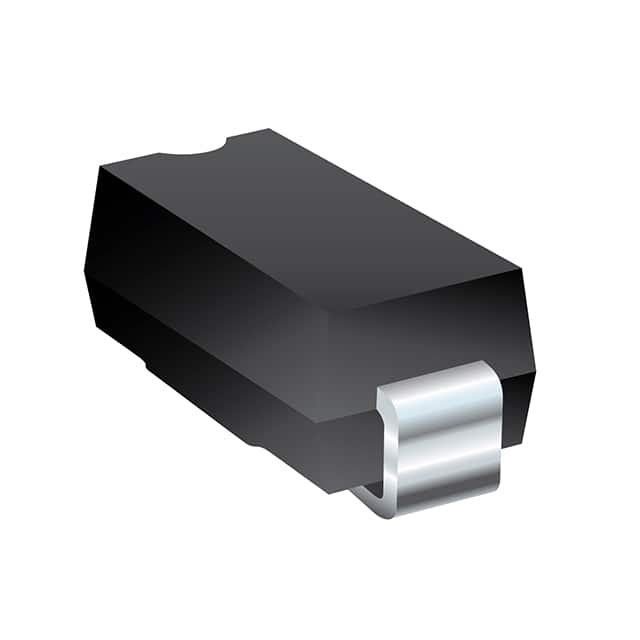SMLJ90A Diode: Encyclopedia Entry
Introduction
The SMLJ90A diode is a crucial component in the field of electronics and electrical engineering. This encyclopedia entry aims to provide a comprehensive overview of the SMLJ90A diode, including its product details, specifications, pin configuration, functional features, advantages and disadvantages, working principles, application field plans, and alternative models.
Product Overview
Category
The SMLJ90A diode belongs to the category of transient voltage suppressor (TVS) diodes.
Use
It is primarily used for surge protection in electronic circuits to prevent damage from voltage spikes.
Characteristics
- High surge capability
- Low clamping voltage
- Fast response time
Package
The SMLJ90A diode is typically available in a DO-214AB (SMC) package.
Essence
The essence of the SMLJ90A diode lies in its ability to rapidly suppress transient voltages and protect sensitive electronic components.
Packaging/Quantity
It is commonly packaged in reels or tubes, with quantities varying based on manufacturer specifications.
Specifications
- Peak Pulse Power: 3000W
- Breakdown Voltage: 90V
- Maximum Clamping Voltage: 146V
- Operating Temperature Range: -55°C to 150°C
Detailed Pin Configuration
The SMLJ90A diode has a standard pin configuration with two terminals, anode, and cathode, as per the DO-214AB package specifications.
Functional Features
- Rapid response to transient voltage spikes
- High surge capability for reliable protection
- Low clamping voltage to minimize stress on connected circuits
Advantages and Disadvantages
Advantages
- Effective surge protection
- Fast response time
- Compact form factor
Disadvantages
- Limited breakdown voltage compared to higher-rated TVS diodes
- Higher clamping voltage than some specialized TVS diodes
Working Principles
The SMLJ90A diode operates by diverting excess transient voltage away from sensitive components, thereby protecting them from potential damage. When a voltage spike occurs, the diode quickly conducts, providing a low-resistance path for the surge current to flow through.
Detailed Application Field Plans
The SMLJ90A diode finds extensive use in various applications, including: - Power supply units - Telecommunication equipment - Automotive electronics - Industrial control systems - Consumer electronics
Detailed and Complete Alternative Models
Some alternative models to the SMLJ90A diode include: - P6SMBJ90A - 1.5KE100A - SMBJ90A
In conclusion, the SMLJ90A diode serves as a critical component in safeguarding electronic circuits from transient voltage events. Its high surge capability, fast response time, and compact form factor make it a valuable asset in diverse electronic applications.
Word count: 433
Lista 10 Vanliga frågor och svar relaterade till tillämpningen av SMLJ90A i tekniska lösningar
What is SMLJ90A?
- SMLJ90A is a type of transient voltage suppressor diode commonly used to protect electronic circuits from voltage spikes and transients.
What are the key features of SMLJ90A?
- SMLJ90A features include a peak pulse power dissipation of 3000W, low clamping voltage, and fast response time.
How does SMLJ90A protect electronic circuits?
- SMLJ90A diverts excessive voltage away from sensitive components by providing a low-impedance path to ground during transient events.
In what applications is SMLJ90A commonly used?
- SMLJ90A is often used in power supplies, telecommunications equipment, automotive electronics, and industrial control systems.
What is the maximum working voltage of SMLJ90A?
- The maximum working voltage of SMLJ90A is 77.8V.
How do I select the right SMLJ90A for my application?
- The selection of SMLJ90A depends on factors such as maximum working voltage, peak pulse current, and clamping voltage requirements.
Can SMLJ90A be used for surge protection in outdoor environments?
- Yes, SMLJ90A can be used for surge protection in outdoor environments, but proper packaging and environmental protection should be considered.
What is the typical response time of SMLJ90A?
- The typical response time of SMLJ90A is less than 1 nanosecond.
Are there any thermal considerations when using SMLJ90A?
- Yes, thermal considerations are important, and proper heat sinking or thermal management may be required for high-power applications.
What are the potential failure modes of SMLJ90A?
- Potential failure modes of SMLJ90A include thermal runaway, overvoltage breakdown, and physical damage due to mechanical stress. Regular testing and monitoring are recommended to ensure proper functionality.


